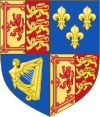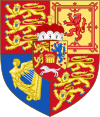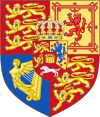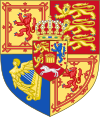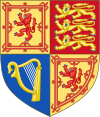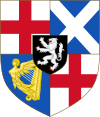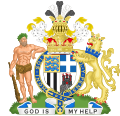Coat of arms of the United Kingdom: Difference between revisions
Beginning to edit 'Uses' section to consolidate the information and improve its flow. |
Major restructure. Shortening infobox by removing image of herald and banners (have own article). Editing 'Use' section for clarity. Shortening 'History' section by removing English and Scottish tables (have own article), but also adding in text summary of history. |
||
| Line 9: | Line 9: | ||
|middle = Royal Coat of Arms of the United Kingdom (Scotland).svg |
|middle = Royal Coat of Arms of the United Kingdom (Scotland).svg |
||
|middle_width = 250 |
|middle_width = 250 |
||
|middle_caption = [[#Scotland| |
|middle_caption = [[#Scotland|The royal coat of arms in Scotland]] |
||
|image2 = Royal Standard of the United Kingdom.svg |
|||
|image2_width = 200 |
|||
|image2_caption = The [[banner of arms]], which serves as a [[Royal Standard of the United Kingdom|royal standard]] |
|||
|image3 = Royal Standard of the United Kingdom (in Scotland).svg |
|||
|image3_width = 200 |
|||
|image3_caption = The [[banner of arms]], which serves as a [[Royal Standard of the United Kingdom|royal standard]] in Scotland |
|||
|image4 = Ströhl-HA-Britischer Herold.png |
|||
|image4_width = 120 |
|||
|image4_caption = English [[Officer of Arms]]'s [[tabard]] |
|||
|armiger = [[Charles III|King Charles III]] in right of [[the Crown]] |
|armiger = [[Charles III|King Charles III]] in right of [[the Crown]] |
||
|year_adopted = 1837 |
|year_adopted = 1837 |
||
| Line 51: | Line 42: | ||
==Uses== |
==Uses== |
||
=== Government and judicial === |
|||
The [[Government of the United Kingdom]] governs in the monarch's name, and uses the royal arms to symbolise its authority.<ref name=":1">{{cite web |date=February 2022 |title=Identity guidelines |url=https://gcs.civilservice.gov.uk/wp-content/uploads/2022/03/HMG_Identity-Guidelines_2022.pdf |publisher=HM Government}}</ref> The coat of arms is used as the government's primary logo, and can therefore be seen documents and forms, passports, in embassies and consulates, and in departmental logos.<ref name=":1" /> The government primarily uses a simplified form of the arms which omits the helm and mantling and reduces the crest to the crown alone. When a logo will be primarily used in Scotland the Scottish version of the arms is used, such as the [[Office of the Secretary of State for Scotland]]; the arms also appear on [[Act of the Scottish Parliament|Acts of the Scottish Parliament]].<ref name=":1" /> The arms are simplified to remove the helm and mantling, but include the full crest. |
The [[Government of the United Kingdom]] governs in the monarch's name, and uses the royal arms to symbolise its authority.<ref name=":1">{{cite web |date=February 2022 |title=Identity guidelines |url=https://gcs.civilservice.gov.uk/wp-content/uploads/2022/03/HMG_Identity-Guidelines_2022.pdf |publisher=HM Government}}</ref> The coat of arms is used as the government's primary logo, and can therefore be seen documents and forms, passports, in embassies and consulates, and in departmental logos.<ref name=":1" /> The government primarily uses a simplified form of the arms which omits the helm and mantling and reduces the crest to the crown alone. When a logo will be primarily used in Scotland the Scottish version of the arms is used, such as the [[Office of the Secretary of State for Scotland]]; the arms also appear on [[Act of the Scottish Parliament|Acts of the Scottish Parliament]].<ref name=":1" /> The arms are simplified to remove the helm and mantling, but include the full crest. |
||
The royal arms appear in courtrooms in England and Wales, typically behind the judge's bench, and symbolise that justice comes from the monarch.<ref name=":2">{{cite web |title=Traditions of the courts|url=https://www.judiciary.gov.uk/about-the-judiciary/the-justice-system/court-traditions/|website=Courts and Tribunals Judiciary|access-date=2 January 2017}}</ref> One exception is the [[magistrates' court (England and Wales)|magistrates' court]] in the [[City of London]].<ref name=":2" /> The Justice ([[Northern Ireland]]) Act 2002 prohibited the display of the royal arms in courtrooms or on court building exteriors in Northern Ireland, with the some exceptions.{{Efn|The [[Royal Courts of Justice, Belfast|Royal Courts of Justice]] in Belfast, the courts in Armagh, Banbridge, Downpatrick, Magherafelt, Omagh, and the exterior of court buildings that had them in place prior to the enactment of the Act.}}<ref>Justice (Northern Ireland) Act 2002 (c.26) 66 [http://www.legislation.gov.uk/ukpga/2002/26/body/enacted Display of Royal Arms at courts]</ref> The arms are not displayed in the [[Middlesex Guildhall]], which houses the [[Supreme Court of the United Kingdom]] and [[Judicial Committee of the Privy Council|Judicial Commitee of the Privy Council]], as the remit of the former includes the entire UK and latter is the final court of appeal for some republics.<ref>{{Cite web |last=Court |first=The Supreme |title=FAQs- The Supreme Court |url=https://www.supremecourt.uk/faqs.html#2c |access-date=2023-05-14 |website=www.supremecourt.uk}}</ref> |
The royal arms appear in courtrooms in England and Wales, typically behind the judge's bench, and symbolise that justice comes from the monarch.<ref name=":2">{{cite web |title=Traditions of the courts|url=https://www.judiciary.gov.uk/about-the-judiciary/the-justice-system/court-traditions/|website=Courts and Tribunals Judiciary|access-date=2 January 2017}}</ref> One exception is the [[magistrates' court (England and Wales)|magistrates' court]] in the [[City of London]].<ref name=":2" /> The Justice ([[Northern Ireland]]) Act 2002 prohibited the display of the royal arms in courtrooms or on court building exteriors in Northern Ireland, with the some exceptions.{{Efn|The [[Royal Courts of Justice, Belfast|Royal Courts of Justice]] in Belfast, the courts in Armagh, Banbridge, Downpatrick, Magherafelt, Omagh, and the exterior of court buildings that had them in place prior to the enactment of the Act.}}<ref>Justice (Northern Ireland) Act 2002 (c.26) 66 [http://www.legislation.gov.uk/ukpga/2002/26/body/enacted Display of Royal Arms at courts]</ref> The arms are not displayed in the [[Middlesex Guildhall]], which houses the [[Supreme Court of the United Kingdom]] and [[Judicial Committee of the Privy Council|Judicial Commitee of the Privy Council]], as the remit of the former includes the entire UK and latter is the final court of appeal for some republics.<ref>{{Cite web |last=Court |first=The Supreme |title=FAQs- The Supreme Court |url=https://www.supremecourt.uk/faqs.html#2c |access-date=2023-05-14 |website=www.supremecourt.uk}}</ref> |
||
The royal arms of the United Kingdom displayed in all courts in [[British Columbia]] and some older courts in [[Ontario]].<ref>{{Cite web |title=Learning your way around a courtroom {{!}} Provincial Court of British Columbia |url=https://www.provincialcourt.bc.ca/enews/enews-09-12-2020 |access-date=2023-05-10 |website=www.provincialcourt.bc.ca}}</ref><ref>{{Cite web |title=Ontario Justice Education Network Handout: Traditions of the Courts |url=https://ojen.ca/wp-content/uploads/Traditions-of-the-Courts.pdf |url-status=live |access-date=10 May 2022}}</ref> In [[Australia]] they were also displayed by all [[Governor-General of Australia|viceroys]] as representation of their Crown authority, and by most state supreme courts across the country. Additionally the [[Western Australian Legislative Council]] has also adopted them as its own symbol.{{cn|date=October 2022}} |
|||
[[File:Day 36 - Gotta Catch 'Em All (cropped).jpg|thumb|left|The Royal Shield formed by six UK coins, with the [[One pound (British coin)|£1 coin]] depicting the whole of the shield.]] |
|||
=== Banner of arms === |
|||
{{See also|Royal Standard of the United Kingdom}} |
|||
A banner of the royal arms, known as the Royal Standard, is flown from buildings in which the monarch is resident or present. The [[Palace of Westminster]], for example, usually flies the [[Union Flag]], but flies the Royal Standard when the monarch is present for the [[State Opening of Parliament]]. When the monarch is not in residence at a palace in Scotland the [[Royal Banner of Scotland]] is flown; palaces in the rest of the UK fly the Union Flag. |
|||
=== Coinage === |
|||
[[File:Day 36 - Gotta Catch 'Em All (cropped).jpg|thumb|The Royal Shield formed by six UK coins, with the [[One pound (British coin)|£1 coin]] depicting the whole of the shield.]] |
|||
The royal arms regularly feature on British coinage. In 2008 a new series of designs for all seven coins of £1 and below was unveiled by the Royal Mint, every one of which is drawn from the royal arms. The full royal arms appear on the one pound coin, and sections appear on each of the other six, which combine to form a complete depiction.<ref>{{Cite web|url=https://www.royalmint.com/our-coins/|archiveurl=https://web.archive.org/web/20080404064611/http://www.royalmint.com/newdesigns/designsRevealed.aspx|url-status=dead|title=Our Coins | The Royal Mint|archivedate=4 April 2008|website=www.royalmint.com}}</ref> |
The royal arms regularly feature on British coinage. In 2008 a new series of designs for all seven coins of £1 and below was unveiled by the Royal Mint, every one of which is drawn from the royal arms. The full royal arms appear on the one pound coin, and sections appear on each of the other six, which combine to form a complete depiction.<ref>{{Cite web|url=https://www.royalmint.com/our-coins/|archiveurl=https://web.archive.org/web/20080404064611/http://www.royalmint.com/newdesigns/designsRevealed.aspx|url-status=dead|title=Our Coins | The Royal Mint|archivedate=4 April 2008|website=www.royalmint.com}}</ref> |
||
[[File:Lion and Unicorn - geograph.org.uk - 902236.jpg|thumb|[[St Michael's Parish Church, Linlithgow|St Michael's Parish Church]], [[Linlithgow|Linlithgow, Scotland]]: Scottish version of the royal arms of the [[House of Hanover|Hanoverian]]s, used from 1801 to 1816]] |
|||
The monarch grants [[Royal warrant of appointment (United Kingdom)|royal warrant]]s to select businesses and tradespeople which supply the Royal Household with goods or services. This entitles those businesses to display the royal arms on their packaging and stationery by way of advertising. |
|||
=== Ecclesiastical === |
|||
[[File:Lion and Unicorn - geograph.org.uk - 902236.jpg|thumb|[[St Michael's Parish Church, Linlithgow|St Michael's Parish Church]], [[Linlithgow|Linlithgow, Scotland]]: Scottish version of the royal arms of the [[House of Hanover|Hanoverian]]s, used from 1801 to 1816|left]] |
|||
It is customary (but not mandatory) for churches of the [[Church of England]] and [[Church of Scotland]] to display the royal arms to show loyalty to the Crown.<ref>{{cite book |title=Treasures of Britain and Treasures of Ireland |publisher=Drive Publications |edition=1976 |page=677}} Retrieved 15 March 2014.</ref><ref>{{cite web |date=30 May 2013 |title=Royal Arms in church |url=http://www.intriguing-history.com/royal-arms-in-church/ |access-date=31 July 2015 |publisher=Intriguing History}}</ref> If a church building of either denomination does not have a royal arms, permission from the Crown must be given before one can be used.<ref>{{cite book |last=Hasler |first=Charles |url=https://archive.org/details/royalarmsitsgrap0000hasl |title=The Royal Arms — Its Graphic And Decorative Development |date=1980 |publisher=Jupiter Books |isbn=978-0904041200 |url-access=registration}}</ref> |
|||
=== Commercial === |
|||
It is customary (but not mandatory) for churches throughout the United Kingdom whether in the [[Church of England]] or the [[Church of Scotland]] to display the royal arms to show loyalty to the Crown.<ref>{{cite book|title=Treasures of Britain and Treasures of Ireland|edition=1976|publisher=Drive Publications|page=677}} Retrieved 15 March 2014.</ref><ref>{{cite web|url=http://www.intriguing-history.com/royal-arms-in-church/|title=Royal Arms in church|date=30 May 2013|publisher=Intriguing History|access-date=31 July 2015}}</ref> If a church building of either denomination does not have a royal arms, permission from the Crown must be given before one can be used.<ref>{{cite book|last=Hasler|first=Charles|title=The Royal Arms — Its Graphic And Decorative Development|publisher=Jupiter Books|date=1980|isbn=978-0904041200|url-access=registration|url=https://archive.org/details/royalarmsitsgrap0000hasl}}</ref> |
|||
The monarch grants [[Royal warrant of appointment (United Kingdom)|royal warrant]]s to select businesses and tradespeople which supply the royal household with goods or services. This entitles those businesses to display the royal arms on their packaging and stationery by way of advertising. |
|||
The UK newspaper ''[[The Times]]'' uses the Hanoverian royal arms as a logo, with ''[[The Sunday Times]]'' using the current version. The current royal arms are also used by Australian newspaper ''[[The Age]]'' and New Zealand newspaper, ''[[The Press]]''. |
|||
A banner of the royal arms, known as the [[Royal Standard (United Kingdom)|Royal Standard]], is flown from the royal palaces when the monarch is in residence, [[Windsor Castle]] and [[Buckingham Palace]] being principal abodes; and from public buildings only when the monarch is present. For instance, the Royal Standard only flies over the [[Palace of Westminster]] when the monarch is delivering the [[speech from the throne]] in the [[House of Lords]] at the [[State Opening of Parliament]]. This protocol equally applies to the monarch's principal residences in Scotland (the [[Palace of Holyroodhouse]] and [[Balmoral Castle]]), where the Royal Standard (Scottish version) is flown. When the monarch is not in residence the [[Union Flag]], or in Scotland the ancient [[Royal Standard of Scotland]], is flown. |
|||
==History== |
|||
The widely sold British newspaper ''[[The Times]]'' uses the Hanoverian royal arms as a logo, whereas its sister publication, ''[[The Sunday Times]]'', displays the current version. Likewise, the Australian newspaper ''[[The Age]]'' and the New Zealand newspaper, ''[[The Press]]'', uses the insignia as their logo. |
|||
===England and Scotland=== |
|||
{{Main articles|Royal arms of England|Royal arms of Scotland}} |
|||
The origin of the current royal arms is arms of the the Kingdom of England and Kingdom of Scotland, both adopted in the twelfth century. The English arms were quartered with those of France from 1340 (except 1360-69), representing the [[English claims to the French throne|English claim to the French throne]]. The arms of Scotland remained unaltered except during the reign of [[Mary, Queen of Scots]], when they were first impaled with those of her husband, [[Francis II of France]], and then quartered to represent Mary's [[Mary, Queen of Scots#Claim to the English throne|claim to the English throne]]. Similarly, during the reign of [[Mary I of England]] her arms were impaled with those of her husband, [[Philip II of Spain]]. |
|||
In 1603 [[James VI and I|James VI of Scotland]] inherited the English and Irish thrones, and to symbolise this [[Union of the Crowns|union of the crowns]] the arms of England (including France) and Ireland were quartered with those of Scotland. In 1689 [[Mary II of England|Mary II]] and [[William III of England|William III]] became co-monarchs and impaled their arms; both used the royal arms, with William also bearing an [[Escutcheon (heraldry)|inescucheon]] of [[House of Orange-Nassau|Nassau]], the royal house to which he belonged. |
|||
The royal arms of the United Kingdom displayed in all courts in [[British Columbia]] and some older courts in [[Ontario]].<ref>{{Cite web |title=Learning your way around a courtroom {{!}} Provincial Court of British Columbia |url=https://www.provincialcourt.bc.ca/enews/enews-09-12-2020 |access-date=2023-05-10 |website=www.provincialcourt.bc.ca}}</ref><ref>{{Cite web |title=Ontario Justice Education Network Handout: Traditions of the Courts |url=https://ojen.ca/wp-content/uploads/Traditions-of-the-Courts.pdf |url-status=live |access-date=10 May 2022}}</ref> In [[Australia]] they were also displayed by all [[Governor-General of Australia|viceroys]] as representation of their Crown authority, and by most state supreme courts across the country. Additionally the [[Western Australian Legislative Council]] has also adopted them as its own symbol.{{cn|date=October 2022}} |
|||
During the [[Commonwealth of England|Commonwealth]] and [[The Protectorate]] in the mid-seventeenth century the arms were significantly changed, as the monarchy had been abolished. The Irish harp continued to be used, but England was represented by [[Flag of England|St George's Cross]] and Scotland by [[Flag of Scotland|St Andrew's Cross]]. These were impaled in various ways, and from 1655 to 1659 also included the arms of the Lord Protector, Oliver Cromwell, on an inescutcheon. |
|||
=== Great Britain === |
|||
The royal arms were controversially used by former Prime Minister [[Margaret Thatcher]] as her official letterhead from {{circa|1997|lk=yes}}.<ref>{{cite news |last1=Summers |first2=Ben |last2=Streeter |first1=Michael |title=The strange case of Lady Thatcher and Her Majesty's coat of arms |url=https://www.independent.co.uk/news/the-strange-case-of-lady-thatcher-and-her-majestys-coat-of-arms-1274739.html |newspaper=The Independent |date=24 March 1997 |access-date=20 July 2017}}</ref> |
|||
The [[Acts of Union 1707]] formed the [[Kingdom of Great Britain]] from England and Scotland. The arms of the new kingdom impaled England and Scotland in the first and fourth quarters, representing their union, with France in the second and Ireland in the third. In 1714 the [[Electorate of Hanover|Elector of Hanover]], [[George I of Great Britain|George I]], became king and the arms of Hanover were placed in the fourth quarter. |
|||
=== United Kingdom === |
|||
In 1801 Great Britain and Ireland were [[Acts of Union 1800|united]] to form the United Kingdom and the British claim to the French throne was dropped. This resulted in the removal of the French quarter from the royal arms and the rearrangement of the remaining quarters so that (outside Scotland) England occupied the first and fourth, Scotland the second, Ireland the third, and Hanover an inescucheon topped by an electoral bonnet. Within Scotland the Scottish and English quarters were reversed. In 1816 the electorate of Hanover became a kingdom, and the bonnet was replaced with a crown in the royal arms. |
|||
In 1837 Victoria became queen of the United Kingdom but not Hanover, as the latter followed Salic law which barred women from the succession. The Hanoverian quarter was therefore dropped, and the royal arms reached the form they have retained to the present. The only changes since have been cosmetic, such as altering the depiction of the Irish harp so that it no longer included a bare-breasted woman. |
|||
===Ireland=== |
===Ireland=== |
||
Unlike the |
Unlike the Acts of Union 1707 with Scotland, the Acts of Union 1800 with Ireland did not provide for a separate Irish version of the royal arms.{{dubious|1706/7 says "the quartering the Arms, and the Rank and Precedency of the Lyon King of Arms of the Kingdom of Scotland as may best suit the Union, be left to her Majesty" and 1800 says nothing for or against. If the contention is that the 1800 acts have been interpreted as FORBIDDING separate royal arms for Ireland, then that requires specific cites.|date=November 2017}} The [[Arms of Ireland#Achievement|crest of the Kingdom of Ireland]] ("on a wreath Or and Azure, a tower triple-towered of the First, from the portal a hart springing Argent attired and unguled Or") has had little or no official use since the union. |
||
When the [[Irish Free State]] established [[Great Seal of the Irish Free State|its own diplomatic seals]] in the 1930s, the royal arms appearing on them varied from those on their UK equivalents by having the Irish arms in two-quarters and the English arms in one.<ref>{{cite journal|last=Hanley|first=Hugh|year=2015|title='The Last Shadow': Negotiating the Great Seal and Direct Access to the King, 1931|journal=Irish Studies in International Affairs|publisher=Royal Irish Academy|volume=26|pages=257–274 : 266 |doi=10.3318/isia.2015.26.13 |jstor=10.3318/isia.2015.26.13|s2cid=156763438 |
When the [[Irish Free State]] established [[Great Seal of the Irish Free State|its own diplomatic seals]] in the 1930s, the royal arms appearing on them varied from those on their UK equivalents by having the Irish arms in two-quarters and the English arms in one.<ref>{{cite journal |last=Hanley |first=Hugh |year=2015 |title='The Last Shadow': Negotiating the Great Seal and Direct Access to the King, 1931 |journal=Irish Studies in International Affairs |publisher=Royal Irish Academy |volume=26 |pages=257–274 : 266 |doi=10.3318/isia.2015.26.13 |jstor=10.3318/isia.2015.26.13 |s2cid=156763438}}; {{cite web |last=Walshe |first=Joseph |author-link=Joseph Walshe |date=26 October 1937 |title=Memorandum on external seals |url=http://difp.ie/viewdoc.asp?DocID=2243 |access-date=20 September 2011 |work=Documents on Irish Foreign Policy, Vol. V No. 97 |publisher=[[Royal Irish Academy]]}}</ref> |
||
=== Wales === |
=== Wales === |
||
[[Wales]] is not directly represented in the royal arms, as after the passage of the [[Laws in Wales Acts 1535 and 1542]] the nation was considered an integral part of England. A [[Welsh Dragon|Welsh dragon]] was used as a supporter by the [[Tudor period|Tudor]] monarchs, who were of Welsh descent, but this was replaced with the current Scottish unicorn when the Stuart dynasty inherited the throne. |
|||
In the 20th century |
In the 20th century the [[Royal Badge of Wales|arms of the principality of Wales]] were added as an inescutcheon to the [[coat of arms of the Prince of Wales]], and a banner of those arms with a green inescutcheon bearing the prince's crown is flown as his personal standard in Wales. There is also a [[Royal Badge of Wales]], which include the arms of the principality and which is used, among other things, on the cover of Acts of the Welsh Parliament.<ref>{{Cite news |date=2008-07-09 |title=First Welsh law's royal approval |language=en-GB |url=http://news.bbc.co.uk/2/hi/uk_news/wales/wales_politics/7497491.stm |access-date=2023-05-14}}</ref> |
||
== |
== Development == |
||
===Kingdoms of England and Scotland=== |
|||
The current royal arms are a combination of the arms of the former kingdoms that make up the [[United Kingdom]], and can be traced back to the first arms of the kings of England and kings of Scotland. Various alterations occurred over the years as the arms of other realms acquired or claimed by the kings were added to the royal arms. The table below tracks the changes in the royal arms from the original arms of King Richard I of England, and William I, King of Scots. |
|||
=== Great Britain and the United Kingdom === |
|||
{| cellpadding="0" cellspacing="0" border="0" border="1" cellpadding="4" cellspacing="0" style="width:100%; margin:0.5em 1em 0.5em 0; background:#f9f9f9; border:1px #aaa solid; border-collapse:collapse;" |
|||
{| style="width:100%; margin:0.5em 1em 0.5em 0; background:#f9f9f9; border:1px #aaa solid; border-collapse:collapse;" cellspacing="0" cellpadding="4" border="1" |
|||
|- |
|- |
||
| colspan="3" style="background:#ccf; text-align:center;" |'''The royal coats of arms of the Kingdom of Great Britain (1707-1801) and United Kingdom (1801-present)''' |
|||
| |
|||
{| style="width:100%;" cellpadding="0" cellspacing="0" |
|||
|- style="text-align:center; background:#ccf;" |
|||
| style="width:50%; "| '''[[Kingdom of England]]''' |
|||
| style="width:50%; "| '''[[Kingdom of Scotland]]''' |
|||
|- |
|- |
||
! style="width:20%;" |Arms |
|||
<!-- Left Column --> |
|||
! style="width:10%;" |Dates |
|||
! style="width:70%;" |Details |
|||
{| border="1" border="1" cellpadding="4" cellspacing="0" style="width:100%; margin:0.5em 1em 0.5em 0; background:#f9f9f9; border:1px #aaa solid; border-collapse:collapse;" |
|||
|- |
|- |
||
| <div class="center">[[File:Royal Arms of Great Britain (1707-1714).svg|100px]] [[File:Arms of Great Britain in Scotland (1707-1714).svg|100px]]</div>||1707–1714||{{commons category|Coats of arms of Queen Anne of Great Britain}}The [[Acts of Union 1707]] created the [[Kingdom of Great Britain]] (1707–1800). The royal arms of England and Scotland are impaled (as for a married couple) and moved to the first and fourth quarters, France second quarter and Ireland third quarter.<ref name="Boutell" /> |
|||
! style="width:25%;"| Arms |
|||
! style="width:20%;"| Dates |
|||
! style="width:55%;"| Details |
|||
|- |
|- |
||
| <div class="center">[[File:Royal Arms of Great Britain (1714-1801).svg|100px]] [[File:Arms of Great Britain in Scotland (1714-1801).svg|100px]]</div>||1714–1800||{{commons category multi|Coats of arms of King George I of Great Britain|Coats of arms of King George II of Great Britain}}[[George I of Great Britain|The Elector of Hanover]] inherited the throne following the death of Queen Anne under the provisions of the [[Act of Settlement 1701]], becoming King George I. The fourth quarter of the arms was changed to reflect the new King's domain of [[Electorate of Hanover]]. This consisted of the two lions of the [[Duchy of Brunswick|Brunswick]], the rampant lion with hearts of [[Lüneburg]] and the horse of Hanover, surmounted by the [[Imperial Crown of the Holy Roman Empire]] for the Holy Roman office of Archbannerbearer/[[Archtreasurer]]).<ref name="Boutell" /> |
|||
| align=center | [[File:Richard_I_1st_seal.png|x120px]] |
|||
| 1189–1198 |
|||
| Arms shown on [[Richard I of England|King Richard I]]'s first [[Great Seal of the Realm|Great Seal]]. The tinctures and the appearance of the full shield are uncertain. |
|||
|- |
|- |
||
| <div class="center">[[File:Royal Arms of United Kingdom (1801-1816).svg|100px]] [[File:Arms of the United Kingdom in Scotland (1801-1816).svg|100px]]</div>||1801–1816||{{commons category|Coats of arms of King George III of the United Kingdom}}The [[Acts of Union 1800]] united the Kingdoms of [[Kingdom of Great Britain|Great Britain]] and [[Kingdom of Ireland|Ireland]]. At the same time, [[George III of the United Kingdom|King George III]] abandoned his ancestors' ancient claim to the French throne (France [[First French Republic|had become a republic]]). The royal arms changed, with England now occupying the first and fourth quarters, Scotland the second, Ireland the third. The royal arms used in Scotland has Scotland occupying the first and fourth quarters, England the second, Ireland the third. For the [[Prince-elector|Electorate]] of Hanover, there is an [[inescutcheon]] surmounted by the electoral bonnet.<ref name="Boutell" /> The Arms of [[Electorate of Brunswick-Lüneburg|Hanover]] were similar, but lacked the electoral bonnet. |
|||
| align=center | [[File:Royal Arms of England (1198-1340).svg|x120px]] |
|||
| 1198–1340 |
|||
| The arms on the second Great Seal of King Richard the Lionheart, used by his successors until 1340: three golden lions ''[[attitude (heraldry)#Passant|passant gardant]]'', on a red field.<ref name="Boutell"/> |
|||
|- |
|- |
||
| <div class="center">[[File:Royal Arms of United Kingdom (1816-1837).svg|100px]] [[File:Arms of the United Kingdom in Scotland (1816-1837).svg|100px]]</div>||1816–1837||{{commons category multi|Coats of arms of King George III of the United Kingdom|Coats of arms of King George IV of the United Kingdom|Coats of arms of King William IV of the United Kingdom}}The electoral bonnet was replaced by a crown in 1816, as [[Kingdom of Hanover|Hanover]] had been declared a kingdom two years previous.<ref name="Boutell" /> |
|||
| align=center | [[File:Royal Arms of England (1340-1367).svg|x120px]] |
|||
| 1340–1377<br/> |
|||
| [[Edward III of England|King Edward III]] quartered the royal arms of England with the ancient arms of France, the [[fleur-de-lis|fleurs-de-lis]] on a blue field, to signal [[English claims to the French throne|his claim to the French throne]].<ref name="Boutell"/> |
|||
|- |
|- |
||
|<div class="center">[[File:Arms of the United Kingdom.svg|100px]] [[File:Royal Arms of the United Kingdom (Scotland).svg|100px]]</div>||1837–present|||{{commons category|Coats of arms of Queen Victoria of the United Kingdom}}The accession of [[Queen Victoria]] ended the [[personal union]] between the United Kingdom and Hanover, as [[Salic law]] prevented a woman from ascending the Hanoverian throne, and the inescutcheon of the arms of Hanover was removed.<ref name="Boutell" /> There was no attempt to alter the royal arms to reflect later titles acquired by the British monarch such as [[Emperor of India]]. The harp of the [[Kingdom of Ireland]] remained despite [[Partition of Ireland|partition]] in 1921, to represent Northern Ireland. |
|||
| align=center | [[File:Royal Arms of England (1395-1399).svg|x120px]] |
|||
| 1377–1399 |
|||
Depictions of the harp having varied between a simple version of the Gaelic harp (as shown here) and a more elaborate version featuring a head and breast of a winged maiden, traditionally the Maid of Erin, as the pillar. Historically the Maid of Erin harp was more prevalent and remains in use in the [[Royal Standard of the United Kingdom]], however the plain version has recently been more commonly used in part because of the personal preference of [[Elizabeth II|Queen Elizabeth II]].<ref>[http://www.loeser.us/flags/british_note_6.html British Royal Standards since 1801] David Prothero and Martin Grieve. Retrieved 13 May 2011.</ref> |
|||
| [[Richard II of England|King Richard II]] impaled the royal arms of England with the arms [[attributed arms|attributed]] to King [[Edward the Confessor]].<ref name="Boutell"/> |
|||
|- |
|||
| align=center | [[File:Royal Arms of England (1399-1603).svg|x120px]] |
|||
| 1399–1422 |
|||
| [[Henry IV of England|King Henry IV]] updated the French arms to the [[France moderne|modern version]], three [[fleurs-de-lis]] on a blue field.<ref name="Boutell"/> |
|||
|- |
|||
| align=center | [[File:Royal Arms of England (1470-1471).svg|x120px]] |
|||
| 1422–1461<br/>1470–1471 |
|||
| [[Henry VI of England|King Henry VI]] impaled the French and English arms, using the same arms after his [[Henry VI of England#Return to the throne|"readeption"]].<ref>[http://www.heraldica.org/topics/britain/pics/h6_salut.jpg heraldica.org]. ''Heraldica''. Retrieved 2 June 2020.</ref> |
|||
|- |
|||
| align=center | [[File:Royal Arms of England (1399-1603).svg|x120px]] |
|||
| 1461–1470<br />1471–1554 |
|||
| [[Edward IV of England|King Edward IV]] restored the arms of King Henry IV. |
|||
|- |
|||
| align=center | [[File:Royal Arms of England (1554-1558).svg|x120px]] |
|||
| 1554–1558 |
|||
| [[Mary I of England|Queen Mary I]] impaled her arms with those of her husband, [[Philip II of Spain|King Philip of Spain]].<ref name="Boutell"/> Although Queen Mary I's father, [[Henry VIII of England|King Henry VIII]], assumed the title "[[King of Ireland]]" and this was further conferred upon King Philip, the arms were not altered to feature the [[Kingdom of Ireland]]. |
|||
|- |
|||
| align=center | [[File:Royal Arms of England (1399-1603).svg|x120px]] |
|||
| 1558–1603 |
|||
| [[Elizabeth I of England|Queen Elizabeth I]] restored the arms of King Henry IV.<ref name="Boutell"/> |
|||
|} |
|||
<!-- Right Column --> |
|||
| style="width:50%; vertical-align:top;"| |
|||
{| border="1" border="1" cellpadding="4" cellspacing="0" style="width:100%; margin:0.5em 1em 0.5em 0; background:#f9f9f9; border:1px #aaa solid; border-collapse:collapse;" |
|||
|- |
|||
! style="width:25%;"| Arms |
|||
! style="width:20%;"| Dates |
|||
! style="width:55%;"| Details |
|||
|- |
|||
| align=center | [[File:Alexander II (Alba) ii.JPG|x120px]] |
|||
| 1214-1249 |
|||
| [[Obverse and reverse|Reverse]] of [[Alexander II of Scotland|Alexander II's]] [[Great Seal of Scotland|Great Seal]], displaying the [[Lion rampant]] on saddle and shield. |
|||
|- |
|||
| align=center | [[File:Royal Arms of the Kingdom of Scotland.svg|x120px]] |
|||
| Before 1558 |
|||
| A red lion, ''[[attitude (heraldry)#Rampant|rampant]]'', on a yellow field within a double royal tressure, flory counter-flory. |
|||
|- |
|||
| align=center | [[File:Royal Arms of the Kingdom of Scotland (1558).svg|x120px]] |
|||
| 1558 |
|||
| [[Mary, Queen of Scots]], [[Dauphine of France]], impaled with arms of [[Francis II of France|Francis]], [[Dauphin of France]].<ref name=coinage>{{Cite web|url=http://www.niceasso.net/cnumisnice/default.asp?a=6174|archiveurl=https://web.archive.org/web/20080226164840/http://www.niceasso.net/cnumisnice/default.asp?a=6174|url-status=dead|title=The Franco-Scots Coinage of Mary Stuart and Francis II|archivedate=26 February 2008}}</ref> |
|||
|- |
|||
| align=center | [[File:Royal Arms of the Kingdom of Scotland (1558-1559).svg|x120px]] |
|||
| 1558–1559 |
|||
| [[Mary, Queen of Scots]], [[Dauphine of France]], impaled with the [[dimidiation|dimidated]] arms of [[Francis II of France|Francis]], [[Dauphin of France]], as [[List of Scottish consorts|King consort of Scots]].<ref name=coinage /> |
|||
|- |
|||
| align=center | [[File:Royal Arms of the Kingdom of Scotland (1559).svg|x120px]] |
|||
| 1559 |
|||
| [[Mary, Queen of Scots]], [[Dauphine of France]], impaled with the dimidated arms of [[Francis II of France|Francis]], [[Dauphin of France]], [[List of Scottish consorts|King consort of Scots]], both halves incorporating [[Mary, Queen of Scots#Claim to the English throne|the claim to the English throne]] made [[Treaty of Edinburgh|for a short time]].<ref>[https://blogs.bl.uk/digitisedmanuscripts/2021/10/elizabeth-and-mary-royal-cousins-rival-queens-curators-picks.html Elizabeth and Mary, Royal Cousins, Rival Queens: Curators' Picks], British Library, 8 October 2021</ref> |
|||
|- |
|||
| align=center | [[File:Royal Arms of the Kingdom of Scotland (1559-1560).svg|x120px]] |
|||
| 1559–1560 |
|||
| Mary, Queen of Scots and [[Queen consort]] of [[List of French consorts|France]]<ref name=coinage /> |
|||
|- |
|||
| align=center | [[File:Royal Arms of the Kingdom of Scotland (1560-1565).svg|x120px]] |
|||
| 1560–1565 |
|||
| Mary, Queen of Scots and [[Queen dowager]] of France.<ref name=coinage /> |
|||
|- |
|||
| align=center | [[File:Royal Arms of the Kingdom of Scotland.svg|x120px]] |
|||
| 1565–1603 |
|||
| Upon her second marriage to [[Henry Stuart, Lord Darnley]], in 1565, Mary discontinued use of the France impalement, reverting to the arms of the [[Kingdom of Scotland]].<ref>{{Cite web|url=http://www.yahoo.com/|title=Yahoo | Mail, Weather, Search, Politics, News, Finance, Sports & Videos|website=www.yahoo.com}}</ref> [[James I of England|King James VI]] was the last monarch of Scotland to use these arms before the [[Union of the Crowns]] in 1603. |
|||
|} |
|||
|} |
|||
|} |
|} |
||
=== |
=== The Commonwealth and Protectorate === |
||
{| |
{| style="width:100%; margin:0.5em 1em 0.5em 0; background:#f9f9f9; border:1px #aaa solid; border-collapse:collapse;" cellspacing="0" cellpadding="4" border="1" |
||
|- |
|- |
||
| colspan="3" |
| colspan="3" style="background:#ccf; text-align:center;" |'''The coats of arms used during the Commonwealth and Protectorate''' |
||
|- |
|- |
||
! style="width:20%;"|Arms |
! style="width:20%;" |Arms |
||
! style="width:10%;"|Dates |
! style="width:10%;" |Dates |
||
! style="width:70%;"|Details |
! style="width:70%;" |Details |
||
|- |
|||
| <div class="center">[[File:Royal Arms of England (1603-1707).svg|100px]] [[File:Royal Arms of the Kingdom of Scotland (1603-1707).svg|100px]]</div>||1603–1649*||[[James I of England|James VI, King of Scots]], inherited the English and Irish thrones in 1603 ([[Union of the Crowns]]), and quartered the royal arms of England with those of Scotland. For the first time, the [[Coat of arms of Ireland|Royal Coat of Arms of Ireland]] was added to represent the [[Kingdom of Ireland]].<ref name="Boutell"/> The [[Royal coat of arms of Scotland|Scottish version]] differs in giving the Scottish elements precedence.<br><br> *Use of the Scottish version, together with the monarchy under [[Charles II of England|Charles II]], continued in Scotland during the period 1649–1651. |
|||
|- |
|- |
||
| <div class="center">[[File:Arms of the Commonwealth of England.svg|130px]]</div>||1649–1654|| |
| <div class="center">[[File:Arms of the Commonwealth of England.svg|130px]]</div>||1649–1654|| |
||
These novel arms, already in use by parliamentarians in 1648, were adopted by the [[Commonwealth of England]] established in 1649.<ref name="Petchey">{{cite book |last=Petchey |first=W.J., Massachusetts |title=A Short Account of the Armorial Bearings of the Sovereigns of England |
These novel arms, already in use by parliamentarians in 1648, were adopted by the [[Commonwealth of England]] established in 1649.<ref name="Petchey">{{cite book |last=Petchey |first=W.J., Massachusetts |title=A Short Account of the Armorial Bearings of the Sovereigns of England |publisher=National Council of Social Service |year=1967 |location=London}}</ref> |
||
|- |
|- |
||
| <div class="center">[[File:Arms of the Commonwealth of England, Scotland and Ireland.svg|130px]]</div>||1654–1655|| |
| <div class="center">[[File:Arms of the Commonwealth of England, Scotland and Ireland.svg|130px]]</div>||1654–1655|| |
||
| Line 200: | Line 136: | ||
{{Cite web |title=April 1654: An Ordinance for uniting Scotland into one Commonwealth with England. {{!}} British History Online |url=https://www.british-history.ac.uk/no-series/acts-ordinances-interregnum/pp871-875 |access-date=2023-01-10 |website=www.british-history.ac.uk}}</ref> |
{{Cite web |title=April 1654: An Ordinance for uniting Scotland into one Commonwealth with England. {{!}} British History Online |url=https://www.british-history.ac.uk/no-series/acts-ordinances-interregnum/pp871-875 |access-date=2023-01-10 |website=www.british-history.ac.uk}}</ref> |
||
|- |
|- |
||
| <div class="center">[[File:Arms of the Protectorate (1653–1659).svg|100px]]</div>||1655–1659|| The arms of the Commonwealth from 1655 to 1659. Struck in 1655, the Great Seal included the personal arms of [[Oliver Cromwell]] on a shield in the centre.<ref name="Boutell"/> |
| <div class="center">[[File:Arms of the Protectorate (1653–1659).svg|100px]]</div>||1655–1659|| The arms of the Commonwealth from 1655 to 1659. Struck in 1655, the Great Seal included the personal arms of [[Oliver Cromwell]] on a shield in the centre.<ref name="Boutell" /> |
||
Blazon: Quarterly 1 and 4 Argent a Cross Gules (England) 2 Azure a Saltire Argent (Scotland) and 3 Azure a Harp Or Stringed Argent (Ireland) on an Inescutcheon Sable a Lion Rampant Argent (Cromwell's arms). The supporters were a crowned lion of England and a red dragon of Wales. The Scottish unicorn was removed, as it was associated with the Stuart Monarchy. The motto read {{lang|la|PAX QUÆRITUR BELLO}} ("peace is obtained through war").<ref>Friar, ''Basic Heraldry'' (1993).</ref> |
Blazon: Quarterly 1 and 4 Argent a Cross Gules (England) 2 Azure a Saltire Argent (Scotland) and 3 Azure a Harp Or Stringed Argent (Ireland) on an Inescutcheon Sable a Lion Rampant Argent (Cromwell's arms). The supporters were a crowned lion of England and a red dragon of Wales. The Scottish unicorn was removed, as it was associated with the Stuart Monarchy. The motto read {{lang|la|PAX QUÆRITUR BELLO}} ("peace is obtained through war").<ref>Friar, ''Basic Heraldry'' (1993).</ref> |
||
|- |
|- |
||
| <div class="center">[[File:Arms of the Commonwealth of England, Scotland and Ireland.svg|130px]]</div>||1659–1660|| |
| <div class="center">[[File:Arms of the Commonwealth of England, Scotland and Ireland.svg|130px]]</div>||1659–1660|| |
||
Following the Protectorate, the 1654 arms were restored. |
Following the Protectorate, the 1654 arms were restored. |
||
|- |
|||
| <div class="center">[[File:Royal Arms of England (1603-1707).svg|100px]] [[File:Royal Arms of the Kingdom of Scotland (1603-1707).svg|100px]]</div>||1660–1689||Charles II restored the royal arms following the [[Restoration (1660)|restoration]] after the [[Wars of the Three Kingdoms|civil wars]]. |
|||
|- |
|||
| <div class="center">[[File:Royal Arms of England (1689-1694).svg|100px]] [[File:Arms of Scotland (1689-1694).svg|100px]]</div>||1689–1694||[[James II of England|King James II & VII]] is deposed and replaced with his daughter [[Mary II of England|Mary II]] and her husband, [[William III of England|William III]]. As King and Queen they [[impalement (heraldry)|impale]]d their arms: William bore the royal arms with an [[Escutcheon (heraldry)|escutcheon]] of [[House of Orange-Nassau|Nassau]] (the royal house to which William belonged) added (a golden lion rampant on a blue field with golden billets), while Mary bore the royal arms undifferenced.<ref name="velde">François Velde's [http://www.heraldica.org/topics/britain/royalarm.htm Heraldica site]</ref><ref>Arnaud Bunel's [http://www.heraldique-europeenne.org/Regions/Iles_Britanniques/Grand-Bretagne.htm#Grandes Héraldique européenne site]{{dead link|date=December 2015}}</ref> |
|||
|- |
|||
| <div class="center">[[File:Royal Arms of England (1694-1702).svg|100px]] [[File:Arms of Scotland (1694-1702).svg|100px]]</div>||1694–1702||After the death of [[Mary II of England|Mary II]], [[William III of England|William III]] reigned alone, and used his arms only.<ref name="Boutell"/><ref name="velde"/> |
|||
|- |
|||
| <div class="center">[[File:Royal Arms of England (1603-1707).svg|100px]] [[File:Royal Arms of the Kingdom of Scotland (1603-1707).svg|100px]]</div>||1702–1707||[[Anne, Queen of Great Britain|Queen Anne]] inherited the throne upon the death of King William III & II, and the royal arms returned to the 1603 version.<ref name="Boutell"/> |
|||
|} |
|||
===After the Acts of Union 1707=== |
|||
{| border="1" border="1" cellpadding="4" cellspacing="0" style="width:100%; margin:0.5em 1em 0.5em 0; background:#f9f9f9; border:1px #aaa solid; border-collapse:collapse;" |
|||
|- |
|||
| colspan="3" style="background:#ccf; text-align:center;"|'''At the [[Acts of Union 1707|Union]] creating Great Britain in 1707, arms were adopted for the new kingdom, and again in 1801 at the [[Acts of Union 1800|Union]] creating the United Kingdom''' |
|||
|- |
|||
! style="width:20%;"|Arms |
|||
! style="width:10%;"|Dates |
|||
! style="width:70%;"|Details |
|||
|- |
|||
| <div class="center">[[File:Royal Arms of Great Britain (1707-1714).svg|100px]] [[File:Arms of Great Britain in Scotland (1707-1714).svg|100px]]</div>||1707–1714||{{commons category|Coats of arms of Queen Anne of Great Britain}}The [[Acts of Union 1707]] created the [[Kingdom of Great Britain]] (1707–1800). The royal arms of England and Scotland are impaled (as for a married couple) and moved to the first and fourth quarters, France second quarter and Ireland third quarter.<ref name="Boutell"/> |
|||
|- |
|||
| <div class="center">[[File:Royal Arms of Great Britain (1714-1801).svg|100px]] [[File:Arms of Great Britain in Scotland (1714-1801).svg|100px]]</div>||1714–1800||{{commons category multi|Coats of arms of King George I of Great Britain|Coats of arms of King George II of Great Britain}}[[George I of Great Britain|The Elector of Hanover]] inherited the throne following the death of Queen Anne under the provisions of the [[Act of Settlement 1701]], becoming King George I. The fourth quarter of the arms was changed to reflect the new King's domain of [[Electorate of Hanover]]. This consisted of the two lions of the [[Duchy of Brunswick|Brunswick]], the rampant lion with hearts of [[Lüneburg]] and the horse of Hanover, surmounted by the [[Imperial Crown of the Holy Roman Empire]] for the Holy Roman office of Archbannerbearer/[[Archtreasurer]]).<ref name="Boutell"/> |
|||
|- |
|||
| <div class="center">[[File:Royal Arms of United Kingdom (1801-1816).svg|100px]] [[File:Arms of the United Kingdom in Scotland (1801-1816).svg|100px]]</div>||1801–1816||{{commons category|Coats of arms of King George III of the United Kingdom}}The [[Acts of Union 1800]] united the Kingdoms of [[Kingdom of Great Britain|Great Britain]] and [[Kingdom of Ireland|Ireland]]. At the same time, [[George III of the United Kingdom|King George III]] abandoned his ancestors' ancient claim to the French throne (France [[First French Republic|had become a republic]]). The royal arms changed, with England now occupying the first and fourth quarters, Scotland the second, Ireland the third. The royal arms used in Scotland has Scotland occupying the first and fourth quarters, England the second, Ireland the third. For the [[Prince-elector|Electorate]] of Hanover, there is an [[inescutcheon]] surmounted by the electoral bonnet.<ref name="Boutell"/> The Arms of [[Electorate of Brunswick-Lüneburg|Hanover]] were similar, but lacked the electoral bonnet. |
|||
|- |
|||
| <div class="center">[[File:Royal Arms of United Kingdom (1816-1837).svg|100px]] [[File:Arms of the United Kingdom in Scotland (1816-1837).svg|100px]]</div>||1816–1837||{{commons category multi|Coats of arms of King George III of the United Kingdom|Coats of arms of King George IV of the United Kingdom|Coats of arms of King William IV of the United Kingdom}}The electoral bonnet was replaced by a crown in 1816, as [[Kingdom of Hanover|Hanover]] had been declared a kingdom two years previous.<ref name="Boutell"/> |
|||
|- |
|||
|<div class="center">[[File:Arms of the United Kingdom.svg|100px]] [[File:Royal Arms of the United Kingdom (Scotland).svg|100px]]</div>||1837–present|||{{commons category|Coats of arms of Queen Victoria of the United Kingdom}}The accession of [[Queen Victoria]] ended the [[personal union]] between the United Kingdom and Hanover, as [[Salic law]] prevented a woman from ascending the Hanoverian throne, and the inescutcheon of the arms of Hanover was removed.<ref name="Boutell"/> There was no attempt to alter the royal arms to reflect later titles acquired by the British monarch such as [[Emperor of India]]. The harp of the [[Kingdom of Ireland]] remained despite [[Partition of Ireland|partition]] in 1921, to represent Northern Ireland. |
|||
Depictions of the harp having varied between a simple version of the Gaelic harp (as shown here) and a more elaborate version featuring a head and breast of a winged maiden, traditionally the Maid of Erin, as the pillar. Historically the Maid of Erin harp was more prevalent and remains in use in the [[Royal Standard of the United Kingdom]], however the plain version has recently been more commonly used in part because of the personal preference of [[Elizabeth II|Queen Elizabeth II]].<ref>[http://www.loeser.us/flags/british_note_6.html British Royal Standards since 1801] David Prothero and Martin Grieve. Retrieved 13 May 2011.</ref> |
|||
|} |
|} |
||
Revision as of 16:25, 14 May 2023
| Royal coat of arms of the United Kingdom | |
|---|---|
 | |
| Versions | |
 | |
| Armiger | King Charles III in right of the Crown |
| Adopted | 1837 |
| Crest | Upon the helm, the imperial crown proper thereon a lion statant guardant Or langued Gules armed Argent, imperially crowned Proper; mantled Or doubled Ermine |
| Shield | Quarterly, I and IV Gules, three lions passant guardant in pale Or langued and armed Azure. II Or a lion rampant Gules armed and langued Azure within a double tressure flory-counter-flory Gules. III Azure a harp Or stringed Argent.; quarters for England and Scotland are exchanged in Scotland. |
| Supporters | On the dexter a lion rampant guardant Or langued and armed Gules, imperially crowned Proper. On the sinister a Unicorn rampant Argent armed crined and unguled Or, and gorged with a Coronet composed of crosses patee and fleurs-de-lis, a chain affixed thereto passing through the forelegs and reflexed over the back Or |
| Compartment | Tudor rose, Shamrock, and Thistle |
| Motto | French: Dieu et mon droit, lit. 'God and my right' |
| Order(s) | Order of the Garter Order of the Thistle (Scottish version) |
| Earlier version(s) | see below |
| Use | On all Acts of Parliament; the cover of all UK passports; various government departments; adapted for the reverse of coins of the pound sterling (2008) |
The royal coat of arms of the United Kingdom is the arms of dominion of the British monarch, currently King Charles III.[1][2] Variants of the royal arms are used by other members of the British royal family, by the Government of the United Kingdom, and some courts and legislatures in a number of Commonwealth realms.
There are two versions of the arms: one used in Scotland, which includes distinctive Scottish elements, and one used elsewhere. The shield of each consists of four quarters depicting the lions of England, the lion of Scotland, and the harp of Ireland. The royal arms developed from the arms of the kingdoms of England, Scotland, and Ireland; as the Kingdom of England included Wales the latter has never been represented individually. The arms serve as basis for the monarch's official flag, the Royal Standard.
Description
Outside Scotland
At the centre of the arms is a quartered shield, depicting the three passant guardant lions of England in the first and fourth quarters, the rampant lion and double tressure flory-counterflory of Scotland in the second quarter, and a harp for Ireland in the third quarter.[3][4] Surrounding the shield is the Order of the Garter, the United Kingdom's most senior order of knighthood.[4] The supporters are a crowned English lion on the dexter (heraldic right), and a chained Scottish unicorn on the sinister (heraldic left).[5] Above the shield is a gold helmet, which has mantling of gold and ermine attached to it. On top of this is the crest, a crown with a crowned lion standing on it. Below the shield is a grassy mound, a type of compartment, on which are thistles, Tudor roses and shamrocks, representing Scotland, England and Ireland respectively.[4] In front of this is the motto Dieu et mon droit, a French phrase meaning 'God and my right'.[4]
During the reign of Elizabeth II the crowns depicted in this version of the royal arms were close representations of St Edward's Crown. Charles III has decided to use the 'Tudor Crown', a design previously introduced at the start of the reign of Edward VII and used until 1952.[6]
In Scotland
The royal arms in Scotland use the same basic elements, but with distinctive Scottish symbolism. In the shield the Scottish arms occupy the first and fourth quarters and the English arms the second, giving the former precedence.[4] The shield is surrounded by the Order of the Thistle. The crest is a crowned red lion holding a sword and sceptre (representing the Honours of Scotland), facing forward sitting on a crown. Above it is the Scots motto 'In defens', a contraction of the phrase 'In my defens God me defend'. The supporters are a crowned and chained Scottish unicorn on the dexter, and a crowned English lion on the sinister. Between each supporter and the shield is a lance displaying the flag of their respective kingdom. The grassy mound beneath the shield contains only thistles; on it is a second motto, that of the Order of the Thistle: Nemo me impune lacessit (No one will attack me with impunity).[4] The crowns in the Scottish version of the arms are conventionally stylised to resemble the Crown of Scotland.
Uses
Government and judicial
The Government of the United Kingdom governs in the monarch's name, and uses the royal arms to symbolise its authority.[7] The coat of arms is used as the government's primary logo, and can therefore be seen documents and forms, passports, in embassies and consulates, and in departmental logos.[7] The government primarily uses a simplified form of the arms which omits the helm and mantling and reduces the crest to the crown alone. When a logo will be primarily used in Scotland the Scottish version of the arms is used, such as the Office of the Secretary of State for Scotland; the arms also appear on Acts of the Scottish Parliament.[7] The arms are simplified to remove the helm and mantling, but include the full crest.
The royal arms appear in courtrooms in England and Wales, typically behind the judge's bench, and symbolise that justice comes from the monarch.[8] One exception is the magistrates' court in the City of London.[8] The Justice (Northern Ireland) Act 2002 prohibited the display of the royal arms in courtrooms or on court building exteriors in Northern Ireland, with the some exceptions.[a][9] The arms are not displayed in the Middlesex Guildhall, which houses the Supreme Court of the United Kingdom and Judicial Commitee of the Privy Council, as the remit of the former includes the entire UK and latter is the final court of appeal for some republics.[10]
The royal arms of the United Kingdom displayed in all courts in British Columbia and some older courts in Ontario.[11][12] In Australia they were also displayed by all viceroys as representation of their Crown authority, and by most state supreme courts across the country. Additionally the Western Australian Legislative Council has also adopted them as its own symbol.[citation needed]
Banner of arms
A banner of the royal arms, known as the Royal Standard, is flown from buildings in which the monarch is resident or present. The Palace of Westminster, for example, usually flies the Union Flag, but flies the Royal Standard when the monarch is present for the State Opening of Parliament. When the monarch is not in residence at a palace in Scotland the Royal Banner of Scotland is flown; palaces in the rest of the UK fly the Union Flag.
Coinage

The royal arms regularly feature on British coinage. In 2008 a new series of designs for all seven coins of £1 and below was unveiled by the Royal Mint, every one of which is drawn from the royal arms. The full royal arms appear on the one pound coin, and sections appear on each of the other six, which combine to form a complete depiction.[13]

Ecclesiastical
It is customary (but not mandatory) for churches of the Church of England and Church of Scotland to display the royal arms to show loyalty to the Crown.[14][15] If a church building of either denomination does not have a royal arms, permission from the Crown must be given before one can be used.[16]
Commercial
The monarch grants royal warrants to select businesses and tradespeople which supply the royal household with goods or services. This entitles those businesses to display the royal arms on their packaging and stationery by way of advertising.
The UK newspaper The Times uses the Hanoverian royal arms as a logo, with The Sunday Times using the current version. The current royal arms are also used by Australian newspaper The Age and New Zealand newspaper, The Press.
History
England and Scotland
The origin of the current royal arms is arms of the the Kingdom of England and Kingdom of Scotland, both adopted in the twelfth century. The English arms were quartered with those of France from 1340 (except 1360-69), representing the English claim to the French throne. The arms of Scotland remained unaltered except during the reign of Mary, Queen of Scots, when they were first impaled with those of her husband, Francis II of France, and then quartered to represent Mary's claim to the English throne. Similarly, during the reign of Mary I of England her arms were impaled with those of her husband, Philip II of Spain.
In 1603 James VI of Scotland inherited the English and Irish thrones, and to symbolise this union of the crowns the arms of England (including France) and Ireland were quartered with those of Scotland. In 1689 Mary II and William III became co-monarchs and impaled their arms; both used the royal arms, with William also bearing an inescucheon of Nassau, the royal house to which he belonged.
During the Commonwealth and The Protectorate in the mid-seventeenth century the arms were significantly changed, as the monarchy had been abolished. The Irish harp continued to be used, but England was represented by St George's Cross and Scotland by St Andrew's Cross. These were impaled in various ways, and from 1655 to 1659 also included the arms of the Lord Protector, Oliver Cromwell, on an inescutcheon.
Great Britain
The Acts of Union 1707 formed the Kingdom of Great Britain from England and Scotland. The arms of the new kingdom impaled England and Scotland in the first and fourth quarters, representing their union, with France in the second and Ireland in the third. In 1714 the Elector of Hanover, George I, became king and the arms of Hanover were placed in the fourth quarter.
United Kingdom
In 1801 Great Britain and Ireland were united to form the United Kingdom and the British claim to the French throne was dropped. This resulted in the removal of the French quarter from the royal arms and the rearrangement of the remaining quarters so that (outside Scotland) England occupied the first and fourth, Scotland the second, Ireland the third, and Hanover an inescucheon topped by an electoral bonnet. Within Scotland the Scottish and English quarters were reversed. In 1816 the electorate of Hanover became a kingdom, and the bonnet was replaced with a crown in the royal arms.
In 1837 Victoria became queen of the United Kingdom but not Hanover, as the latter followed Salic law which barred women from the succession. The Hanoverian quarter was therefore dropped, and the royal arms reached the form they have retained to the present. The only changes since have been cosmetic, such as altering the depiction of the Irish harp so that it no longer included a bare-breasted woman.
Ireland
Unlike the Acts of Union 1707 with Scotland, the Acts of Union 1800 with Ireland did not provide for a separate Irish version of the royal arms.[dubious ] The crest of the Kingdom of Ireland ("on a wreath Or and Azure, a tower triple-towered of the First, from the portal a hart springing Argent attired and unguled Or") has had little or no official use since the union.
When the Irish Free State established its own diplomatic seals in the 1930s, the royal arms appearing on them varied from those on their UK equivalents by having the Irish arms in two-quarters and the English arms in one.[17]
Wales
Wales is not directly represented in the royal arms, as after the passage of the Laws in Wales Acts 1535 and 1542 the nation was considered an integral part of England. A Welsh dragon was used as a supporter by the Tudor monarchs, who were of Welsh descent, but this was replaced with the current Scottish unicorn when the Stuart dynasty inherited the throne.
In the 20th century the arms of the principality of Wales were added as an inescutcheon to the coat of arms of the Prince of Wales, and a banner of those arms with a green inescutcheon bearing the prince's crown is flown as his personal standard in Wales. There is also a Royal Badge of Wales, which include the arms of the principality and which is used, among other things, on the cover of Acts of the Welsh Parliament.[18]
Development
Great Britain and the United Kingdom
| The royal coats of arms of the Kingdom of Great Britain (1707-1801) and United Kingdom (1801-present) | ||
| Arms | Dates | Details |
|---|---|---|
| 1707–1714 | Wikimedia Commons has media related to Coats of arms of Queen Anne of Great Britain. | |
| 1714–1800 | Wikimedia Commons has media related to | |
| 1801–1816 | Wikimedia Commons has media related to Coats of arms of King George III of the United Kingdom. | |
| 1816–1837 | Wikimedia Commons has media related to | |
| 1837–present | Wikimedia Commons has media related to Coats of arms of Queen Victoria of the United Kingdom. Depictions of the harp having varied between a simple version of the Gaelic harp (as shown here) and a more elaborate version featuring a head and breast of a winged maiden, traditionally the Maid of Erin, as the pillar. Historically the Maid of Erin harp was more prevalent and remains in use in the Royal Standard of the United Kingdom, however the plain version has recently been more commonly used in part because of the personal preference of Queen Elizabeth II.[19] | |
The Commonwealth and Protectorate
| The coats of arms used during the Commonwealth and Protectorate | ||
| Arms | Dates | Details |
|---|---|---|
| 1649–1654 |
These novel arms, already in use by parliamentarians in 1648, were adopted by the Commonwealth of England established in 1649.[20] | |
| 1654–1655 |
The Commonwealth of England, Scotland and Ireland (the Protectorate) was created in 1653. St Andrew's Cross was added to the arms in 1654.[21] | |
| 1655–1659 | The arms of the Commonwealth from 1655 to 1659. Struck in 1655, the Great Seal included the personal arms of Oliver Cromwell on a shield in the centre.[3]
Blazon: Quarterly 1 and 4 Argent a Cross Gules (England) 2 Azure a Saltire Argent (Scotland) and 3 Azure a Harp Or Stringed Argent (Ireland) on an Inescutcheon Sable a Lion Rampant Argent (Cromwell's arms). The supporters were a crowned lion of England and a red dragon of Wales. The Scottish unicorn was removed, as it was associated with the Stuart Monarchy. The motto read PAX QUÆRITUR BELLO ("peace is obtained through war").[22] | |
| 1659–1660 |
Following the Protectorate, the 1654 arms were restored. | |
Other variants
Royal family
Members of the British royal family are granted their own personal arms. In the past, the monarch's younger sons used various differences; and married daughters of the monarch impaled the plain royal arms with their husbands' arms. But for many centuries now, all members of the royal family have had differenced versions of the royal arms settled on them by royal warrant.[23] Only children and grandchildren in the male line of the monarch are entitled to arms in this fashion: the arms of children of the monarch are differenced with a three-point label; while grandchildren of the monarch are differenced with a five-point label. An exception is made for the eldest son of the Prince of Wales, who also bears a three-point label. The labels are always white (argent) and each prince or princess has individual marks to form his or her particular difference, except the Prince of Wales, who uses a plain white three-pointed label.[23] Since 1911, the arms of the Prince of Wales also displays an inescutcheon of the ancient arms of the Principality of Wales.[23]
Queens consort and the wives of sons of the monarch also have their own personal coat of arms. Typically this will be the arms of their husband impaled with their own personal arms or those of their father, if armigerous. However, the consorts of a queen regnant are not entitled to use the royal arms. Thus Prince Philip, Duke of Edinburgh was granted his own personal arms. A notable exception to this rule was Prince Albert, who used the royal arms (differenced by a special label) quartered with his own Saxon royal arms.[23]
Currently the following members of the royal family have their own arms based on the royal arms:
| Armorial achievement | Shield | Bearer | Difference(s) |
|---|---|---|---|

|

|
William, Prince of Wales, outside Scotland | The coat of arms of Edward VIII and Charles III as Prince of Wales was the arms of the United Kingdom with a white label of three points and an inescutcheon bearing the arms of Wales. Crowned with the coronet of the Heir-Apparent. As of 23 September 2022[update], William has not been granted these arms or a version of them (see introduction to Coat of arms of the Prince of Wales). The tradition is that the King will grant William, as Prince of Wales, a version of these arms. In the meantime, he uses the plain arms of the heir apparent shown at right. |

|

|
Prince William, Duke of Rothesay, in Scotland | Used in Scotland, the arms of the Duke of Rothesay are those of Clan Stewart of Appin adapted, namely the quartered arms of the Prince and Great Steward of Scotland and Lord of the Isles (secondary titles of the Duke) with an inescutcheon as Scottish heir apparent (the Royal Arms of Scotland with a blue three-point label). |

|
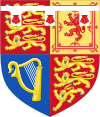
|
Prince Harry, Duke of Sussex | Three-point label with three red escallops in each point, alluding to the patrilineal arms of his mother, Diana, Princess of Wales. The College of Arms has stated that his label would change to one of three points, with each point bearing an escallop, upon his father's or brother's accession to the throne, which occurred in 2022.[24][25][26] |

|
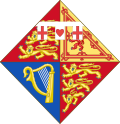
|
Anne, Princess Royal | Three-point label, the points bearing a red cross, a red heart and a red cross.[3] |

|
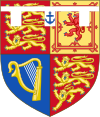
|
Prince Andrew, Duke of York | Three-point label, the centre point bearing a blue anchor.[3] |

|

|
Princess Beatrice, Mrs Edoardo Mapelli Mozzi | Five-point label with three bees in alternate points, alluding to the patrilineal arms of her mother, Sarah, Duchess of York. |

|
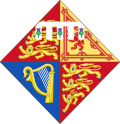
|
Princess Eugenie, Mrs Jack Brooksbank | Five-point label with three thistles in alternate points, alluding to the patrilineal arms of her mother, Sarah, Duchess of York. |

|

|
Prince Edward, Duke of Edinburgh | Three-point label, the centre point bearing a Tudor rose. |
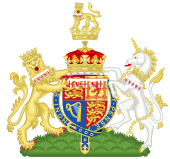
|

|
Prince Richard, Duke of Gloucester | Five-point label, the first, third and fifth points bearing a red cross, the second and fourth points bearing a red lion.[3] |

|

|
Prince Edward, Duke of Kent | Five-point label, the first, third and fifth points bearing a blue anchor, the second and fourth points bearing a red cross.[3] |

|

|
Princess Alexandra, The Hon. Lady Ogilvy | Five-point label, the first and fifth points bearing a red heart, the second and fourth points bearing a blue anchor, and the third bearing a red cross.[3] |
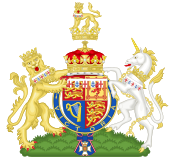
|

|
Prince Michael of Kent | Five-point label, the first, third and fifth points bearing a red cross, the second and fourth points bearing a blue anchor.[3] |
| Consorts | |||

|

|
Queen Camilla | The arms of the King impaled with those of Camilla's father, Major Bruce Shand, crowned with the royal crown.[27] |

|

|
Catherine, Princess of Wales | The arms of the Prince of Wales impaled with those of Catherine's father, Michael Middleton, crowned with the coronet of her husband as the heir apparent.[28] |

|

|
Meghan, Duchess of Sussex | The arms of the Duke of Sussex impaled with those of her own design, crowned with the coronet of a child of the sovereign.[29] |

|

|
Sophie, Duchess of Edinburgh | The arms of the Duke of Edinburgh impaled with those granted in 1999 to Sophie's father, Christopher Rhys-Jones, with remainder to his elder brother Theo. The new grant was based on an unregistered 200-year-old design. The lion alludes to one of the Duchess's ancestors, the Welsh knight Elystan Glodrydd, prince of Ferrig.[30] |

|

|
Birgitte, Duchess of Gloucester | The arms of the Duke of Gloucester with an escutcheon of pretence granted to her by Royal Warrant on 18 July 1973.[31] |
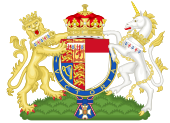
|

|
Katharine, Duchess of Kent | The arms of the Duke of Kent impaled with those of the Duchess's father, Sir William Worsley, 4th Baronet. |

|
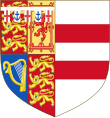
|
Princess Michael of Kent | The arms of Prince Michael of Kent impaled with those of Marie Christine's father, Baron Günther Hubertus von Reibnitz. |
-
Coat of arms of Albert, Prince Consort
-
Coat of arms of Prince Philip, Duke of Edinburgh
Government
Various versions of the royal arms are used by the Government of the United Kingdom, the Parliament of the United Kingdom and courts in some parts of the Commonwealth.
The UK Government generally uses a simplified version of the royal arms with a crown replacing the helm and crest, and with no compartment.[32] In relation to Scotland, the Scotland Office and the Advocate General for Scotland use the Scottish version, again without the helm or crest, and the same was used as the day-to-day logo of the Scottish Executive until September 2007, when a rebranding exercise introduced the name Scottish Government, together with a revised logo incorporating the flag of Scotland.[33] The Scottish Government continues to use the Arms on some official documents.
The simplified royal arms also feature:
- on all Acts of Parliament;
- on the cover of all UK passports and passports issued in other British territories and dependencies;
- as an inescutcheon on the diplomatic flags of British Ambassadors; and
- on all acts of the Anguilla House of Assembly, the Sovereign Base Areas, Pitcairn Islands and South Georgia and the South Sandwich Islands administrations;
- on The London Gazette.
Various courts in the Commonwealth also continue to use the royal arms:
- The Court of Appeal, Supreme Court and Provincial Court of British Columbia[34][35]
- The Supreme Court of Newfoundland and Labrador[36] and Court of Appeal of Newfoundland and Labrador[37]
- The Supreme Court of the Yukon Territory[38]
- The Supreme Court of South Australia[39]
- The Supreme Court of Victoria[40]
Furthermore:
- The crowned shield of the royal arms encircled by the Garter is used by the Home Office, by the Privy Council Office (United Kingdom), and by the Parliament of Victoria.[41]
- The crowned shield of the royal arms is used by the Royal Mint.
- The royal arms with the crest but without the helm is used as the rank insignia for Class 1 Warrant Officers in His Majesty's Armed Forces.
Blazon
This table breaks down the official blazons to enable comparison of the differences between the general coat and the coat used in Scotland.
| Everywhere except Scotland | Scotland | |
|---|---|---|
| Quarterly I & IV | Gules three lions passant gardant in pale Or armed and langued Azure | Or a lion rampant Gules armed and langued Azure within a double tressure flory-counter-flory of the second |
| Quarterly II | Or a lion rampant Gules armed and langued Azure within a double tressure flory-counter-flory of the second | Gules three lions passant gardant in pale Or armed and langued Azure |
| Quarterly III | Azure a harp Or stringed Argent | |
| Surrounded by | The Garter circlet | The collar of the Order of the Thistle |
| Crest | Upon the Royal helm the imperial crown proper, thereon a lion statant gardant Or imperially crowned proper | Upon the Royal helm the crown of Scotland proper, thereon a lion sejant affronté Gules armed and langued Azure, imperially crowned proper holding in his dexter paw a sword and in his sinister a sceptre, both proper |
| Supporters | Dexter a lion rampant gardant Or imperially crowned proper, sinister a unicorn Argent, armed, crined and unguled Or, gorged with a coronet Or composed of crosses patée and fleurs de lis a chain affixed thereto passing between the forelegs and reflexed over the back also Or | Dexter a unicorn Argent imperially crowned proper, armed, crined and unguled Or, gorged with a coronet Or composed of crosses patée and fleurs de lis a chain affixed thereto passing between the forelegs and reflexed over the back also Or holding the standard of Saint Andrew, sinister a lion rampant gardant Or imperially crowned proper holding the standard of Saint George |
| Motto | Dieu et mon Droit (French) | In My Defens God Me Defend, abbr. In Defens (Scots) |
| Order Motto | Garter: Honi soit qui mal y pense (Old French) | Thistle: Nemo me impune lacessit (Latin) |
| Plants on the compartment | Roses, thistles and shamrocks (on the same stem) | Thistles only |
See also
- Flag of the United Kingdom
- Cadency labels of the British royal family
- Armorial of the House of Plantagenet
- Arms of Canada - Canada's arms are closely modelled on the Royal Coat of Arms of the United Kingdom
- Coat of arms of Ireland - Ireland uses the medieval arms of Ireland that are incorporated into the Royal Coat of Arms of the United Kingdom
References
- ^ Berry, Ciara (15 January 2016). "Coats of arms". The Royal Family. The Royal Household. Retrieved 3 October 2020.
- ^ p. 10, Government identity system (2012). HM Government. "The Queen is Head of State, and the United Kingdom is governed by Her Majesty's Government in the name of the Queen. The royal coat of arms is personal to the Queen and..."
- ^ a b c d e f g h i j k l m Brooke-Little, J. P. (1978) [1950]. Boutell's Heraldry (Revised ed.). London: Frederick Warne LTD. pp. 205–222. ISBN 0-7232-2096-4.
- ^ a b c d e f "Coats of Arms". royal.uk. Retrieved 10 May 2023.
{{cite web}}: CS1 maint: url-status (link) - ^ "Royal Arms of the United Kingdom, as used in England". Britannica Kids. Retrieved 10 May 2023.
- ^ "Royal Cypher - College of Arms".
- ^ a b c "Identity guidelines" (PDF). HM Government. February 2022.
- ^ a b "Traditions of the courts". Courts and Tribunals Judiciary. Retrieved 2 January 2017.
- ^ Justice (Northern Ireland) Act 2002 (c.26) 66 Display of Royal Arms at courts
- ^ Court, The Supreme. "FAQs- The Supreme Court". www.supremecourt.uk. Retrieved 14 May 2023.
- ^ "Learning your way around a courtroom | Provincial Court of British Columbia". www.provincialcourt.bc.ca. Retrieved 10 May 2023.
- ^ "Ontario Justice Education Network Handout: Traditions of the Courts" (PDF). Retrieved 10 May 2022.
{{cite web}}: CS1 maint: url-status (link) - ^ "Our Coins | The Royal Mint". www.royalmint.com. Archived from the original on 4 April 2008.
- ^ Treasures of Britain and Treasures of Ireland (1976 ed.). Drive Publications. p. 677. Retrieved 15 March 2014.
- ^ "Royal Arms in church". Intriguing History. 30 May 2013. Retrieved 31 July 2015.
- ^ Hasler, Charles (1980). The Royal Arms — Its Graphic And Decorative Development. Jupiter Books. ISBN 978-0904041200.
- ^ Hanley, Hugh (2015). "'The Last Shadow': Negotiating the Great Seal and Direct Access to the King, 1931". Irish Studies in International Affairs. 26. Royal Irish Academy: 257–274 : 266. doi:10.3318/isia.2015.26.13. JSTOR 10.3318/isia.2015.26.13. S2CID 156763438.; Walshe, Joseph (26 October 1937). "Memorandum on external seals". Documents on Irish Foreign Policy, Vol. V No. 97. Royal Irish Academy. Retrieved 20 September 2011.
- ^ "First Welsh law's royal approval". 9 July 2008. Retrieved 14 May 2023.
- ^ British Royal Standards since 1801 David Prothero and Martin Grieve. Retrieved 13 May 2011.
- ^ Petchey, W.J., Massachusetts (1967). A Short Account of the Armorial Bearings of the Sovereigns of England. London: National Council of Social Service.
{{cite book}}: CS1 maint: multiple names: authors list (link) - ^ "April 1654: An Ordinance for uniting Scotland into one Commonwealth with England. | British History Online". www.british-history.ac.uk. Retrieved 10 January 2023.
- ^ Friar, Basic Heraldry (1993).
- ^ a b c d Moncreiffe, Iain; Pottinger, Don (1954). Simple Heraldry Cheerfully Illustrated. Thomas Nelson and Sons. pp. 40–41.
- ^ College of Arms. "College of Arms – the coat of arms of TRH Prince William and Prince Henry of Wales". Archived from the original on 27 May 2008. Retrieved 17 April 2010.
- ^ "Coat of Arms". Prince Harry. Clarence House. Archived from the original on 24 March 2016. Retrieved 12 April 2016.
- ^ "The Coat of Arms of HRH Prince Henry of Wales". College of Arms. Retrieved 10 December 2017.
- ^ "Camilla's coat of arms unveiled". BBC News. 17 July 2005.
- ^ "Coat of Arms of Duchess of Cambridge". dukeandduchessofcambridge.org. 14 November 2012. Archived from the original on 6 November 2012.
- ^ "Her Royal Highness The Duchess of Sussex: Coat of Arms". The Royal Family. 25 May 2018. Retrieved 25 May 2018.
- ^ Sophie's new coat. BBC News. 19 May 1999. Retrieved 14 November 2010.
- ^ Boutell, Charles; Brooke-Little, John Philip (1978). Boutell's Heraldry (8th revised ed.). Frederick Warne. p. 226. ISBN 9780723220961.
- ^ GOV.UK, Departments, agencies and public bodies [1]. Retrieved 10 August 2013
- ^ "New Lord Lyon King of Arms appointed". 5 March 2017. Archived from the original on 5 March 2017. Retrieved 29 July 2021.
- ^ "Court of Appeal – Hearing List". www.courts.gov.bc.ca.
- ^ "Provincial Court of British Columbia". www.provincialcourt.bc.ca.
- ^ "Supreme Court of Newfoundland and Labrador". court.nl.ca. Retrieved 29 July 2021.
- ^ "Home". Court of Appeal of Newfoundland and Labrador. Retrieved 29 July 2021.
- ^ "Supreme Court". www.yukoncourts.ca.
- ^ "SUPREME COURT ACT 1935 – SECT 15". www.austlii.edu.au.
- ^ "The Supreme Court of Victoria". www.supremecourt.vic.gov.au.
- ^ "Parliament of Victoria – Home". www.parliament.vic.gov.au.
External links
- Coats of Arms at the Lord Chamberlain's Office
- Heraldica.org- The Royal Arms of Great Britain
- Government identity system HM Government
Cite error: There are <ref group=lower-alpha> tags or {{efn}} templates on this page, but the references will not show without a {{reflist|group=lower-alpha}} template or {{notelist}} template (see the help page).
- Personal coats of arms
- British coats of arms
- British monarchy
- National coats of arms
- National symbols of the United Kingdom
- Coats of arms with lions
- Coats of arms with harps
- Coats of arms with fleurs de lis
- Coats of arms with unicorns
- Coats of arms with chains
- Coats of arms with thistles
- Coats of arms with roses
- Coats of arms with shamrocks
- Coats of arms with crowns
- Church architecture
- National emblems
- Royal arms of European monarchs


